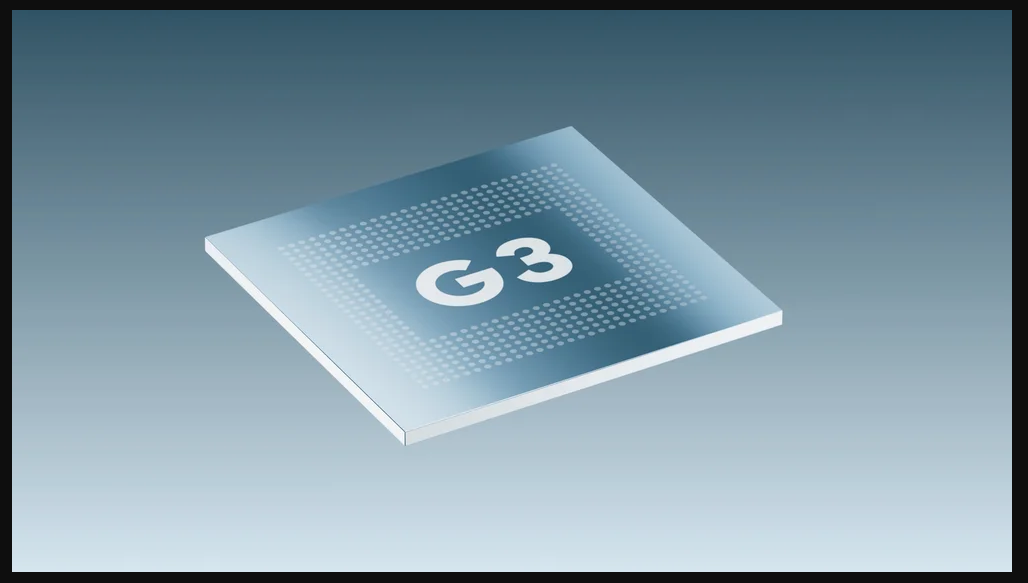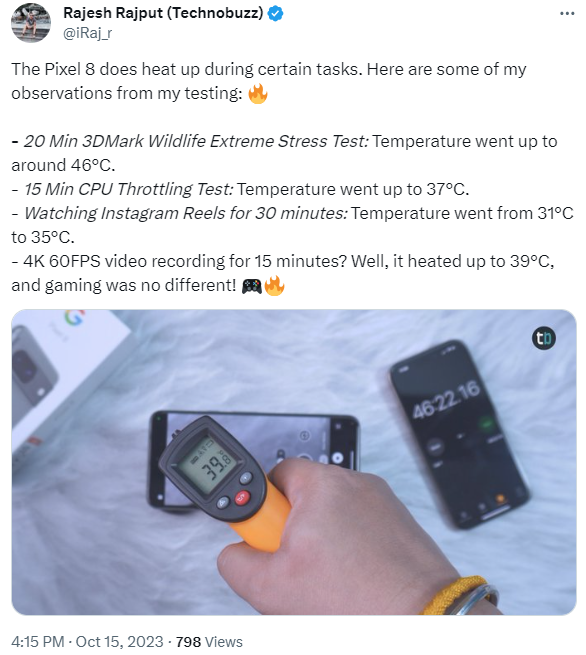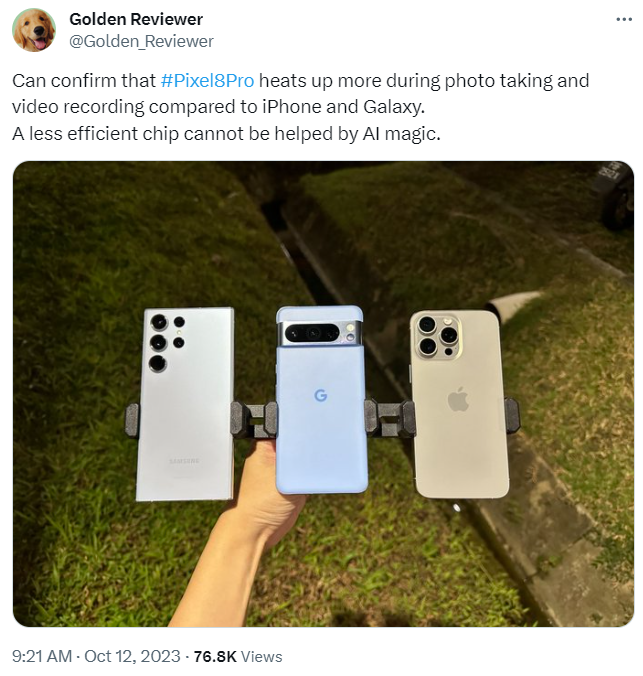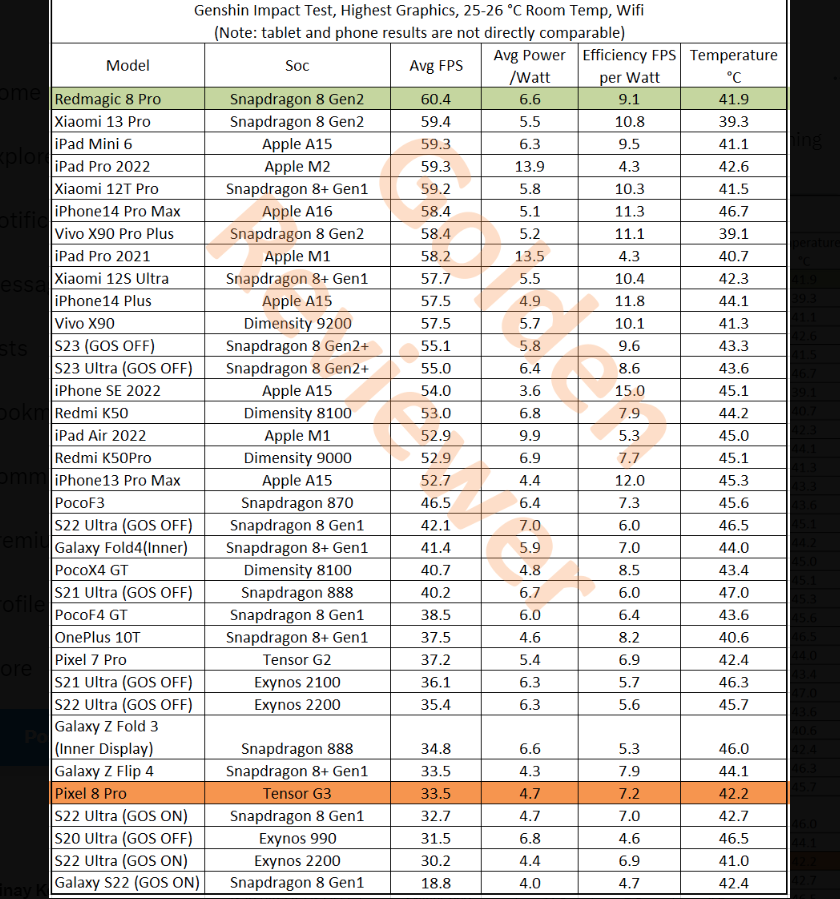The Google Pixel 8 and Pixel 8 Pro were released this month with many new AI features. Thanks to Google’s focus on custom AI cores, the phone now has a new feature called Magic Editor and Best Take. Best Take swaps out faces and makes Group Photos easier. You can change the angle and framing of your photos with the Magic Editor.
The Tensor chip also enables AI features like Magic Eraser and Photo Unblur. The Tensor G3 features the Pixel Visual Core, a custom ISP from Google. It also dedicated cores for AI tasks. Google also uses a physical hardware security chip. This self-designed chip is the third-gen Tensor and still uses the 4nm Samsung node.
Interestingly, Google didn’t talk much about the Tensor G3 chip. The chip was built from the ground up to facilitate AI but is severely behind the competition regarding AI capabilities. The chip has custom cores to boost the phone’s AI potential. It also has Google’s security chip and custom ISP for image enhancements.
The overall CPU cluster resembles the MediaTek Dimensity 9200. However, that chip uses TSMC’s 4nm node, and the Tensor G3 uses Samsung’s 4LPP node. The newer 4LPP+ node from Samsung on phones like the Samsung Galaxy S23 FE is allegedly better at performance and thermals. However, Google is using the older 4nm node.
Does the Google Tensor G3 have heating issues?
According to multiple reports online, if you live in a region with ambient temperatures higher than 25C, the Google Tensor G3 has heating issues. Unfortunately, that means people living in regions with hotter climates will face trouble with the Pixel 8 and the Pixel 8 Pro.
However, it’s worth noting that these reports are conflicting for now. In similar ambient temperatures, one source reports that the Pixel 8 heats up with very basic use. The phone apparently runs constantly hot when using Instagram, which is extremely disappointing.
It also has serious throttling issues. To prevent overheating, Google limits the chip’s capabilities, and the initial peak performance does not sustain for very long. After thermal throttling, the phone drops considerably in performance, and it’s even worse than Google’s Tensor G2. We can conclude that Samsung’s 4mn (4LPP) node wasn’t a good choice for thermals.
Midrange phones with the 5nm Samsung node don’t have heating issues since they push for higher efficiency. However, that’s not the case on flagships. The chips must perform while being efficient simultaneously, and the Tensor G3 fails on the performance front.
The report says that the phone also has many call drops and disturbances. This is not the kind of experience people expect after paying flagship money. However, there are conflicting reports since another source suggests that there are no issues with call quality and cellular reception and that 5G speeds are decent.

What is causing the heating issues?
The heating issues are mostly region-dependant. The Pixel 8 and 8 Pro do not heat up as much in relatively cooler climates like the USA. As a result, the reports online are very contradictory.
The Pixel 8 and 8 Pro do not heat up regularly since Google uses a cooling solution. Unfortunately, they still don’t have vapor-cooling chambers or any form of passive cooling. Google is using thick sheets of Copper and Graphite on the Pixel 8 and Pixel 8 Pro to try and control the heat from these phones.
Google has also severely throttled the performance of the Google Tensor G3. A combination of Graphite and Copper and the performance lock ensure that the phone does not run too hot in basic use for most people.
However, we think Silicon Lottery is at play here. When chips are made on the same wafer, they still have a chance of offering different performance. Using the same Silicon Wafer does not guarantee that two chips will have the same amount of performance and thermal efficiency. Many factors cause this variation, like the chip’s location on the wafer, the manufacturing company’s skill and capability, and the Silicon’s purity. The modems appear inconsistent, with many reporting poor signal strength and bad 5G speeds.
You can notice cases of Silicon Lottery in many high-end smartphone chips. The yield rate directly corresponds to this. If the chip’s yield rate is poor, it ties into mixed results. Silicon lottery affects many things, like power consumption and temperature. If a chip wins the Silicon lottery, it’ll have much better power consumption and run cooler. It’s almost like some versions of the Tensor G3 have no such problems, even in hotter regions like India.
Reports from hotter regions state that the Pixel 8 doesn’t overheat, so we can only assume that different people are getting a different experience with the Pixel 8 series. The chip still gets slightly warm when taking photos and videos. However, you can also find reports that the phone gets hot even when changing a wallpaper.
Can Google address this with an update?
The Tensor G3 is undeniably worse than other flagship chips like the A17 Pro from Apple or the 8 Gen 2 from Qualcomm. Pixels have excellent hardware otherwise, one of the best display panels on a phone, excellent software experience and haptics, and more. As always, the only thing letting them down is the choice of chipset.
However, since reports don’t entirely agree that all units suffer from heating issues, we cannot rule out that it is early software. We’ve seen the same with the iPhone 15 Pro and Pro Max. Initially, there were many reports of heating issues when doing simple tasks like using the Instagram app. The phone dips performance a lot in stress tests, too.
Apple later issued a software update that addressed all the heating concerns. They did it within one month of launch. We can attribute the heating issues with long gaming sessions on the iPhone to the 55% yield rate of the 3nm TSMC chips. It’s better to wait for the first software update for the Pixel 8 and 8 Pro before we make any conclusions about heating issues on these products.
If some units don’t have issues, and this is due to early software, Google can fix it. A software update can better optimize the Tensor G3 for the Pixel 8 and 8 Pro. Fixing cellular reception issues with an OTA update is challenging, so you’ll probably have to live with that if you buy a Pixel.
In what situations does the Pixel 8 series heat up?
Due to the weak horsepower of the Tensor G3 chipset, Pixels considerably heat up with intensive tasks. After 20 minutes of a 3D Mark Wildlife Extreme Stress Test, the Pixel 8 reaches 46C, which is not a good temperature. Stability and scores aren’t good either. The CPU performance rapidly dips to around half its original capacity in just a few seconds.

If you run the CPU throttling test app on the Pixel, it might reach up to 37C. That’s not a bad performance, but the throttling result itself is terrible. The scores are extremely low, and there’s very heavy throttling. To try to cool down the phone, Google is severely limiting the capabilities of the CPU. There’s an acceptable 4C rise with Instagram reels, and it’s surprisingly decent, heating up to just 39C with 4K 60FPS video recording for 15 minutes. Thick layers of Copper and Graphite internally definitely help with heat management on the Pixels.
A better SOC also makes a difference in normal tasks. Google’s own Magic Eraser feature works better on the iPhone 15 Pro with the A17 Pro SOC, and it’s slower on Google’s Pixel 8 Pro. The Pixel 8 Pro’s Geekbench scores aren’t particularly excellent, with just 1700 for the single-core test and slightly over 4200 for the multi-core test.
Taking photos and videos are intensive tasks. The SOC performs all the image processing, the ISP is at work, and it’s also responsible for post-processing. The Pixel 8 Pro still heats up more than the iPhone 15 Pro Max and the Galaxy S23 Ultra. AI and software cannot change this. However, others don’t have the problem, and we can assume Google will streamline the experience eventually so that nobody has concerns with heating on the Pixel 8 and 8 Pro.

According to an efficiency test from Golden Reviewer, the Pixel 8 Pro is leagues behind other phones. The Tensor G3 is worse than the Snapdragon 888, which isn’t an excellent chip to begin with. The Snapdragon is a 5nm chip from 2021, and it was notorious for bad heating issues, poor efficiency, and thermal issues all around. The Tensor G3 scores lower, has worse efficiency than the 888 per watt, draws more power per watt, and the performance per GHz is also noticeably worse.
The Tensor G3 is obviously behind the 2022 flagship chip, the Snapdragon 8 Gen 1- which also interestingly uses Samsung’s 4nm node. Qualcomm’s offering is ahead in all the key performance and efficiency metrics, but even that’s not an excellent chip to compare. Since the Tensor G3 cannot match these chips, it’s not worth comparing it to the newer chips. The 8+ Gen 1, 8 Gen 2, and Dimensity 9200 perform much better overall.
It’s worth noting that Exynos 2100 and Exynos 2200 also score significantly higher than the Tensor G3. They use Samsung’s 5nm and 4nm nodes, respectively. Google has to address the performance of the Tensor G3 with a software update since this is severely underperforming.
Throttling issues on the Pixel 8 Pro
Google is trying to control the heat by making the phone perform much worse than it actually can. It’s demonstrated in this test from Golden Reviewer. This test involves playing the game Genshin Impact at the highest possible graphics at 25C, room temperature. Genshin Impact is a CPU and GPU-heavy game, and it seriously stresses the phone’s chip since the graphics, visuals, backgrounds, and movements are very demanding.

The Tensor G3’s result is right there with the worst phones on the list. For context, the Galaxy Z Flip 4, with an 8+ Gen 1, has a hot tiny chassis, a folding screen, and not much room for thermal dissipation. But the Flip 4 performs better than the Tensor G3 with copper and graphite layers to cool the phone down. This is definitely because Google is severely limiting the performance to try and reduce heating concerns.
The phone is obviously worse at Genshin Impact than the iPhone 13 Pro Max and 14 Pro Max, and also worse than the S23, S23 Ultra, and even the iPhone SE 2022- which is preposterous. Phones with old and inefficient chips, like the Exynos 2100, Exynos 2200, and the 8 Gen 1, perform better.
Conclusion
Reports don’t provide conclusive information. So, can’t say if all Pixel 8 and Pixel 8 Pro units have heating issues. However, there’s hope that Google can address these problems with an update because it’s not happening to all units.
The CPU cluster resembles flagship chips like the Dimensity 9200. To make Pixels better at heat, Google must switch to better nodes. The new 4nm Samsung node (4LP++) is allegedly much better than the old Samsung 4nm node. It also has a yield rate that matches TSMC. That’s the only alternative Google has now instead of completely moving to TSMC fabrication.
The Pixel 8 and 8 Pro are still not good choices for gamers or performance enthusiasts. However, the Tensor chip allows for many AI features, which we can’t dismiss. The phone is still recommendable for photography enthusiasts and people who aren’t heavy users. It’s difficult to replicate the Pixel experience on another phone.
Google still has a long way to go with Tensor. The efficiency is straight out of 2021, and it’s not good against the 8 Gen 2. Google’s Tensor doesn’t even have the price advantage anymore. Earlier, Pixels were much cheaper than the competition since the Tensor chip was cheaper to make. Samsung doesn’t charge as much as TSMC for making chips. So, Pixels were cheaper as a result. However, Google increased the prices to 699$ and 999$, which are no longer value phones.